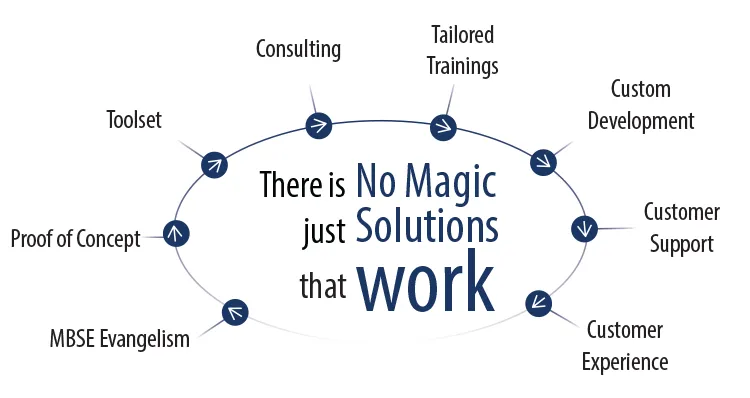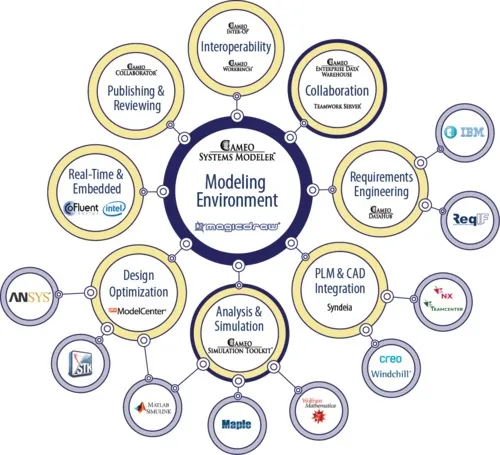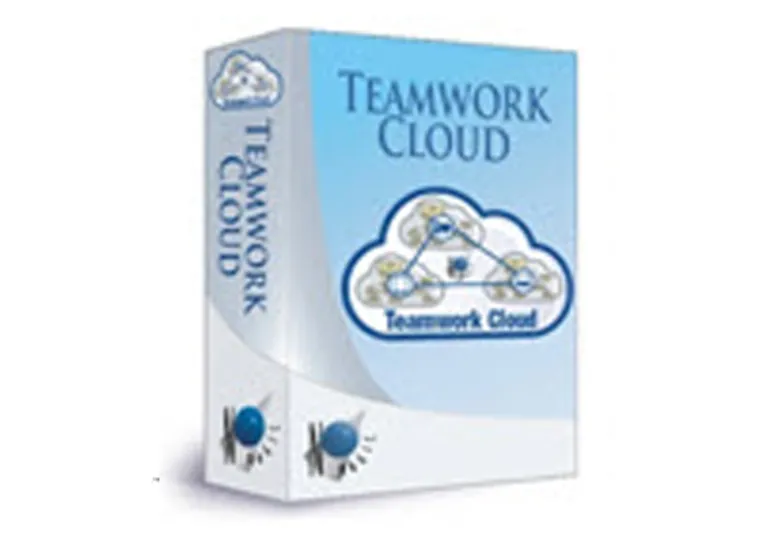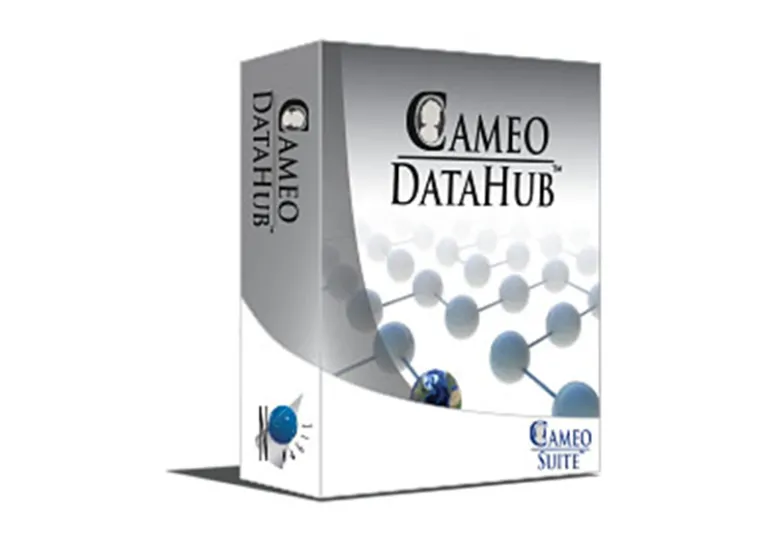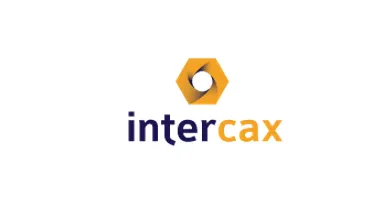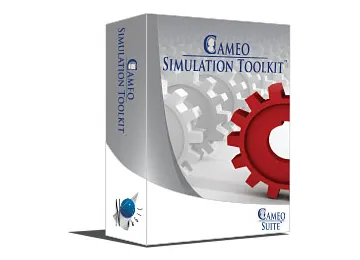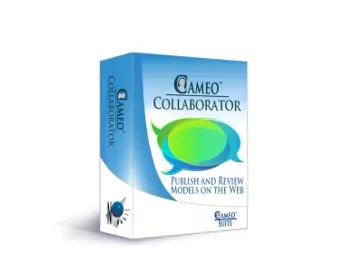Model Based Systems Engineering Solutions
No Magic Model Based Systems Engineering Solutions enables more rigorous requirements traceability with model-based requirements engineering approach.
Model Based Systems Engineering Solutions
Model-Based Systems Engineering (MBSE) provides a robust approach for managing complex systems. By adopting a Model-Based Requirements Engineering method, MBSE improves requirements traceability, ensuring clear communication and collaboration among teams.
No Magic's Model-Based Systems Engineering
No Magic's Model-Based Systems Engineering (MBSE) solution is the most standards compliant application of modeling to support:
- System Requirements
- Analysis and Simulation
- Design
- Verification and Validation
We speak the common language - Systems Modeling Language (SysML 1.6) - which is understood across a significant proportion of the systems engineering community.
Model Based Systems Engineering Key Benefits
Our solution enhances the ability to capture, analyze, share and manage the information associated with the complete specification of a product, resulting in the following benefits:
Improved communications among the stakeholders
Enhanced collaboration among the involved parties
Manage system complexity
Increased ability to manage system complexity by enabling a system model to be viewed from multiple perspectives, and to analyze the impact of changes.
Improved product quality
Improved product quality by providing an unambiguous and precise model of the system that can be evaluated for consistency, correctness and completeness.
Enhanced knowledge capture and reuse
Enhanced knowledge capture and reuse of the information by capturing information in more standardized ways and leveraging built-in abstraction mechanisms inherent in model driven approaches. This in turn can result in reduced cycle time and lower maintenance costs to modify the design
Clarity in Teaching and Learning Systems Engineering
Improved ability to teach and learn systems engineering by providing a clear and unambiguous representation of the concepts.
Executive Overview
MBSE Evangelism. Be wise. Apply best practices while solving difficult problems in various system engineering domains. We cooperate with widely recognized book authors: Sandy Friedenthal, Pascal Roques, Tim Weilkiens and others. We also actively participate in the creation of: OMG Standards SysML, UML, UPDM Working Group (MIWG) and INCOSE MBSE Challenge Teams. We cooperate with multiple universities worldwide, including over 350 Lycees in France using No Magic's tools.
Proof of Concept. Think big, start small, and evolve. Clearly identify your expectations with the team of experts, define goals and project scope, build reference architecture, create main guidelines and evaluate tools. A good beginning makes a good end!
Toolset. Use our fully integrated toolset that gives you the ability to capture, integrate, and maintain standard-based systems engineering models and to precisely model your complex solutions.
Consulting. Gain a competitive advantage with on-line and on-site consultancies during all stages of your project.
Tailored Trainings. Improve your employees' knowledge with dedicated training based on your project environment, new technologies, standards, and best practices.
Custom Development. Exploit the extendibility of our toolset. We implement your business requirements using trustworthy technologies, professionalism and experience.
Customer Support. Tell us what you want to do and we will tell you how to do it.
Customer Experience. Trust the trusted! Find your answer or share your story in our user community. Exploit social networks, user community forum, and blog.
Related Systems Engineering Software Products
- Modeling Environment
- Interoperability
- Collaboration
- Requirements Engineering
Modeling Environment
Cameo Systems Modeler ™ is an industry leading cross-platform collaborative Model-Based Systems Engineering (MBSE) environment, which provides smart, robust, and intuitive tools to define, track, and visualize all aspects of systems in the most standard-compliant SysML models and diagrams. The environment enables systems engineers to:
-
Run engineering analysis for design decisions evaluation and requirements verification
-
Continuously check model consistency
-
Track design progress with metrics
System models can be managed in remote repositories, stored as standard XMI files, or published to documents, images, and web views to address different stakeholder concerns.
Interoperability
Excel and CSV Import add-ons allows mapping and importing any information from Excel or CSV format files into a system model.
Collaboration
Teamwork Cloud (TWC) is CATIA No Magic's next generation repository for collaborative development and version model storage. It is envisioned and architected to provide significant future improvements in the areas of model-governance, model analysis and integration with third-party tools. As the name suggest, this server is Cloud-ready, that can be deployed on a local hardware (VM) or on a Cloud.
Merge plugin enables copying changes between different project versions. This functionality is usually needed when there are several branches that reflect different releases or versions of the product, e.g. when certain fixes have to be copied from a release branch to the mainstream development. Merge functionality in MagicDraw works both on file system files and projects stored in Teamwork Cloud. Learn more
Requirements Engineering
Cameo DataHub. Cameo DataHub is an add-on for Cameo Systems Modeler that allows importing, exporting, synchronizing, and referencing text-based requirements in IBM Rational DOORS, IBM Rational RequisitePro, and CSV format files.
ReqIF Importer is a build-in functionality of Cameo Systems Modeler that supports standard-based requirements exchange among different tools, e.g. IBM Rational DOORS, PTC Integrity, Polarion, Siemens Teamcenter and others. Learn More
Other Related Products
- PLM & CAD
- Simulation & Analysis
- Design Optimization
- Publishing & Reviewing
PLM & CAD
Syndeia add-on from Intercax is an environment where system engineers can connect, communicate, and sync with detailed requirements, parts, bills of materials, CAD (NX, Creo), and complex data structures that are version-managed and configuration-controlled in enterprise-strength PLM systems, such as Teamcenter and Windchill.
Simulation & Analysis
Cameo Simulation Toolkit
enables model execution and user interface prototyping for early system behavior simulation, better understanding, and validation, all with the help of debug and animation, model-based testing, timeline plots, and duration constraint analysis. The toolkit also comes with the built-in parametric solver, scripting engines, and integrations with MATLAB/Simulink, Maple, and Mathematica to perform engineering analysis, such as parametric and topological trade studies, automated requirements verification, mass/cost/power roll-ups, and what-if analysis.
Design Optimization
ModelCenter integration.
MBSEPak add-on for Cameo Systems Modeler allows users to link SysML parametric models with multi-disciplinary analysis models for extensive requirements verification, trade-studies, design-space explorations, automatic design optimizations, and various visualizations developed in ModelCenter - a graphical environment for automation, integration, and design optimization by Phoenix Integration.
Publishing & Reviewing
Cameo Collaborator is an environment that enables simple web-based access to Cameo Systems Modeler models by reducing complexity of the model to several aggregated views matching the needs of your daily work, such as reviewing and approving system requirements or design. Learn more
Report Wizard is a build-in functionality of Cameo Systems Modeler that enables document generations out of the SysML model. It supports text-based report templates such as plain text, Microsoft Word, Microsoft Excel, Microsoft PowerPoint, RTF, HTML, Office Open XML, OpenDocument format, and XML.
Join the conversation in the CATIA MBSE Cyber System User Community!
FAQ About Dassault Systems Model Based Systems Engineering Solutions
NOTE: Existing users of No Magic products can access to the user portal at https://magicdraw.com/main.php, as well as Cameo Collaborator for Teamwork Cloud samples at https://ccexamples.nomagic.com.
Learn What CATIA Can Do for You
Speak with a CATIA expert to learn how our solutions enable seamless collaboration and sustainable innovation at organizations of every size.
Get Started
Courses and classes are available for students, academia, professionals and companies. Find the right CATIA training for you.
Get Help
Find information on software & hardware certification, software downloads, user documentation, support contact and services offering

